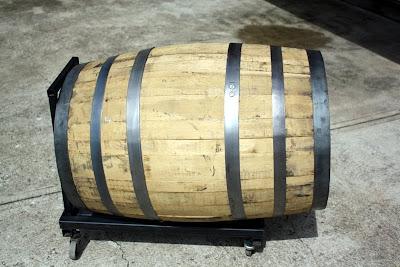We have a large interest in brewing beers that we can age in oak barrels. So, we are going to do an instructional set of posts on how to use 55 gallon oak barrels when homebrewing. The same rules will apply for smaller barrels. The amounts need to be adjusted appropriately, and the aging may differ slightly due to increased surface contact and increased oxygen diffusion in the smaller barrels. These posts will be done as we go through the process and will be accompanied by instructions, recipes, pictures, opinions, and results. This should give everyone a clear picture on what it is to use barrels and what sort of issues need to be addressed when using them. We will be going a few different ways with the barrels. We will be acquiring new American Oak barrels to start with. These are also called North American oak (Quercus alba) or white oak. They will contain high amounts of toasty and vanilla flavors. These will have an intense oak flavor and we will use these to brew BIG beers that can absorb the heavy amounts of oakiness and tannins. As the oak flavors begin to mellow we will eventually switch to sour ales by inundating the barrel with a large set of bugs from dregs and commercially available bacteria and brettanomyces strains. Finally, with enough beer/barrels we will use them for Solera brewing which involves using two or more barrels with different vintages of a beer; then pulling part of the oldest off for consumption and replacing it with newer vintages in series. Hopefully this will be informative to you the reader and for us as well.
Our barrel has been stored dry. This means that it will need to be swelled with hot or cold water to allow the staves to get larger as they soak up the water. This seals any cracks and allows it to hold liquid. We will begin by filling the barrel with 160 degree water. We will do this by adding 13-15 gallons of water at a time in succession to start the sealing process. Using water this hot will also help with sanitization. Using water much hotter than this may results in warped wood. The barrel will then sit for two days with the water remaining in it. After a couple days, if the barrel is of good quality and built correctly there should be no more seepage or leaks. You won’t want the water to remain in there for much more than 2 days for fear of contamination by mold or algae. The curing process may take longer than 2 days. If it does, drain and replace with new water to help avoid contamination. Repeat until the seepage and leaks stop.
After the initial swelling period, we will want to clean the barrel. Because this is a brand new barrel with heavy charring, we want to make sure it is clean, and also remove some of the intense burnt flavors the char will impart. This can be accomplished by using soda ash or BarolKleen. We are using the BarolKleen for ours. Mix 1 pound of BarolKleen for every 5 gallons of barrel space, which means we will use 11 pounds for ours. Then Let this solution rest for 48 hours. This will help leech excess tannins from the barrel.
After the BarolKleen, it needs to be fluhed with water until it runs clear from the barrel. This assures it is well rinsed out. This is followed by a mixture of 2 ounces of Sodium Metabisulphite and 1 ounce of Citric Acid dissolved in 2 gallons of warm water. Pour the solution into the barrel and roll it around so that all internal surfaces are contacted by the solution. Do this for 5 – 10 minutes. Then drain the solution and rinse the barrel well until the water is clear and pure.
The barrel will then be ready for beer. It will need to be filled ASAP to assure that the barrel is clean and free of any bad microbes.







No comments:
Post a Comment